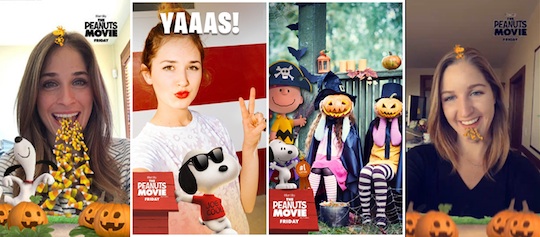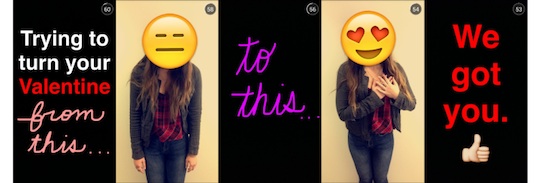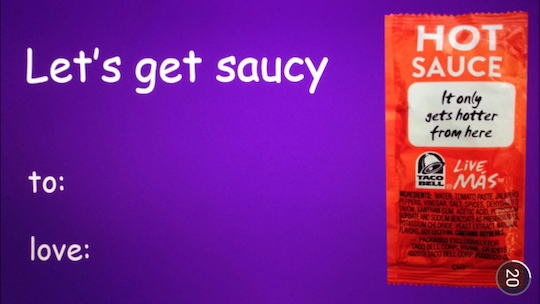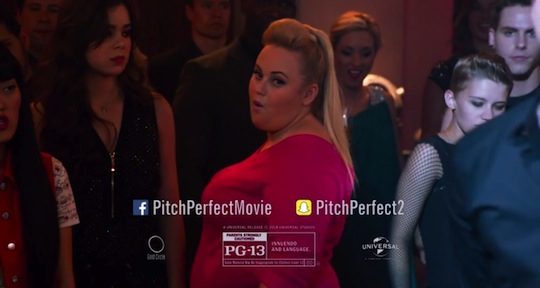Imitation is the sincerest form of flattery for Snapchat marketing
Share
Snapchat has been dubbed a rising star in the marketing world, however the app itself has well and truly established itself as a popular social media platform. The challenge for brands is to harness the app’s popularity in a way that effectively engages with its audience.
If the notion that, in advertising, you want to be where the consumers are, is anything to go by, then Snapchat is definitely a place where brands should be. According to Snapchat, stories within the app can draw tens of millions of viewers per day.
With reach that high, it’s no surprise that brands are eager to assimilate themselves with the app. However the concept of advertising is relatively new to Snapchat. It was just 15 months ago that the first paid ad – a preview of Universal Studios’ horror film, Ouija – was rolled out, in a move that was met with mixed reaction by Snapchat’s users.
It also seems that Snapchat itself is still coming to grips with the best way to feature ads within the app. Upon releasing the Ouija ad, Snapchat posted a statement to its blog, and did its best to assure users that the app wasn’t about to go down the traditional route of sponsored content, but rather position itself as a tool for creative minds to generate engaging content.
“We won’t put advertisements in your personal communication – things like Snaps or Chats. That would be totally rude. We want to see if we can deliver an experience that’s fun and informative, the way ads used to be, before they got creepy and targeted. It’s nice when all of the brilliant creative minds out there get our attention with terrific content,” the statement said.
The key to engagement
Carat Australia Melbourne branch managing director Joseph Pardillo says that the best use of the app from a marketing perspective is for brands to share their stories in the same short, creative snippets that daily users do.
“As everyone fights for the attention span of people, we all of a sudden have an app where you can tell a story of yourself in many different, quick snaps, and if strung together that whole kind of pace around the desire of people or Millennials to tell their story throughout the day, everyday – draws a high level of engagement to the app itself,” he says.
“If brands are able to mimic what the consumer behaviour is all about and in turn use the tech platform to also tell the stories about their own brand through those quick snippets and on-the-go type ways, imagine how powerful that can be,” says Pardillo.
Virtue, Vice’s in-house creative agency, recently teamed up with Cadbury to run a competition promoting the Time Out bar on Snapchat. Users were encouraged to utilise the drawing capabilities of the app and turn pictures presented to them, into unique works of art.
Vice strategic planner Alice Kimberley said the strategy was a huge success, largely because it utilised Snapchat’s features and encouraged users to engage.
“People really want to be creative, but often don’t have the access or outlet, but Snapchat, just being able to draw on the pictures we provided, made it so easy to do and incredibly easy to enter. It wasn’t like a normal competition, you didn’t have to write 200 words, or create a video, it was literally your finger on the screen, working with the existing artwork,” says Kimberley.
Author of The Great Fragmentation, Steve Sammartino, believes the key to getting the right formula for engagement, is a combination of having the right team in place and having trust in them to use the tool creatively.
“One thing that needs to happen is that brands need to have creative people in house and they need to have trust in them. Snapchat isn’t a thing where you can have these contrived social media strategies and those sort of things – Snapchat’s not like that,” says Sammartino.
The power of teaming up with the right people was clearly demonstrated last year when Audi teamed up with satirical news site, The Onion, during Super Bowl to provide people with ‘news that isn’t football. It was the first large-scale Snapchat campaign to achieve major success and emphasizes the point that traditional forms of advertising aren’t going to work as well as campaigns which utilise the features the app offers.
Huge reach is possible
Your Social Voice founder Kim Barrett said the numbers being generated by Snapchat, combined with current trends seeing a spike in users in the 25-40 age bracket, make it an enticing platform for brands to sell their message.
“I think based upon the trend and where it’s going, by the end of the year it’s going to be one of the biggest aggregators of attention, where you can share a snippet of what you’re doing every day, which isn’t just potentially attractive for prospective customers, but also allows you to share your brand message on a platform efficiently and effectively,” says Barrett.
In November last year Universal became the first company to utilise the ‘lenses’ feature, in a one-day campaign to promote the Peanuts Movie. Users were able to click on an icon, which overlayed images of Peanuts characters, Snoopy and Woodstock, around the photo while the show’s theme song played.
The campaign was an effective use of the app’s features, tying in with the notion, that to effectively communicate with consumers, a brand must use the app in the same manner that the audience does. Although successful, the campaign came with a hefty price tag. The Financial Times reported that the ad cost Universal US$750,000 for the one-day, which may be why others haven’t been quick to adopt the same approach.
Ad prices are something Snapchat have been heavily criticised for ever since they opened their doors to paid promotion.
However if done correctly, the large price can be a solid investment. At this year’s Super Bowl Gatorade followed in the footsteps of the Peanuts movie and created a sponsored lens, where users could take a snap in which a giant bucket of Gatorade is dumped on their head, as is tradition with the coach of the winning team at the Super Bowl.
It was a massive success for the company. According to Gatorade, the lens had over 100 million views and although
#SB50 may be over but the #GatoradeDunk @Snapchat lens lives on with 100 million+ views! Get dunked today. pic.twitter.com/1b7FHwE7No
— Gatorade (@Gatorade) February 8, 2016
Snapchat launched its ‘Discovery’ feature in an attempt to help ads become innovative, however some questioned the effectiveness of using the feature to promote, especially given the hefty price tag attached.
Pardillo, believes that the Discovery feature is problematic in the sense that it doesn’t truly utilise Snapchat’s functionality.
“Going down the path of creating handles and using the Snapchat Discovery functionality is probably still a bit funky and not maximising the app itself, but when you start to talk about creating filters and allowing brands to influence the functionality that the app is mainly used for, that’s the area I think that will be the first cab off the rank in terms of really maximising the benefit of what this app is all about,” says Pardillo.
However Kimberley suggests the discovery feature is a great way for companies to introduce themselves to users.
“Great brands are using discovery overseas. If you waddle in there as a brand and just expect audiences to watch your story, you’re very naïve, you need to earn your stripes with Snapchat in a lot of ways. That’s why the discovery feature and leveraging influencers is so important in the first instance. It gets an audience primed and ready to engage with your content,” Kimberley says.
It seems as though Snapchat is in the early stages of making advertisement more accessible for smaller companies, recently slashing its ad prices from US$750,000 to US$100,000.
As the technology continues to evolve, companies will need to become more innovative in order to engage with users.
US fast food chain Taco Bells is an early adopter of this approach, employing a team of two Millenials to form an in-house Snapchat team. The team are responsible for crafting content specifically for the ‘Stories’ section of the app three times a week.
The team has been a success for the company, who received high praise for their Valentines Day campaign last year.
The campaign allowed users to send their Valentine a fun taco-themed snap and was the perfect example of a company using the app in the same way its consumers do.
We haven’t seen this sort of innovation in Australia yet, but Barrett believes, that as the app grows, so to will the time and effort companies put in to it.
“I haven’t seen any companies down here doing it to that scale, but I’ve seen some individuals pushing quite hard. I think by around June we’ll have some emerging companies on there and as the year progresses it will become better known, but at the moment there is still reluctance towards it,” says Barrett.
The reluctance towards Snapchat stems from a mix of a lack of understanding of the technology and the lingering effects from an image problem associated with the app in its early years.
However, Barrett believes any reservations towards the brand are unfounded and those who choose to become early adopters will reap the rewards.
“There’s a reluctance, but I think it is shifting. It’s very similar to the way that not many people wanted to be on Instagram, but as soon as they rolled-out Instagram ads, everyone wanted to be on there. Rolex and other big brands were trying to push on there as hard as they could as soon as that was coming up,” he says
“So I think there is a reluctance still, but all that means is that the people who are early adopters, or people who want to jump into it with two feet are going to have an advantage at the end of the year when it becomes more widely used,” says Barrett.
Snapchat is known as a tool that engages with Millennials, therefore it’s only natural to assume that it’s really only of any use, in a marketing sense, to companies trying to reach that elusive market. However Barrett believes there’s room for businesses of all types on the app.
“I think it’s a great platform and I’ve seen a wide range of different people on there. It’s a really effective platform and unless your business is somewhat secretive, like a private investigator, I think it’s pretty suitable for a business in pretty much any scope,” he says.
Similarly, Sammartino argues that Snapchat isn’t any less suitable to a brand than any other form of social media.
“Different forums suit different brands, but I think Snapchat is appropriate for most brands. I think that if Twitter is appropriate for your brand, then Snapchat certainly is,” he says.
While Kimberley agrees with the notion that Snapchat is a Millenial based app, she believes the perception of a Millenial is incorrect and doesn’t see it as a reason for companies to shy away from using the app.
“If you look at it from a demographic perspective, most Millenials are 25-34. People that age are buying houses and have kids. So the perception it’s for youth is incorrect and needs to be updated,” says Kimberley.
“This is a fantastic acquisition tool in terms of saliency with younger audiences. I don’t think there’s a better tool to get those younger audiences and I cant think of a brand right now that shouldn’t be recruiting Millenials,” she says.
Marketing during live events
Live events provide further opportunity for brands to cash in as well. Through Snapchat, it’s very possible for brands to get themselves involved in real-time conversations surrounding particular events, without having to pay large sums of money to become official sponsors.
This has traditionally been the domain of Twitter, however given the type of platform Snapchat is, further audience engagement through interactive features is highly achievable, which can create more meaningful consumer engagement.
Again, Australian companies are a little behind when it comes to this, but overseas, it’s becoming more and more prevalent.
For example, last year’s Superbowl saw brands including Mountain Dew and GrubHub, join the conversation, with interactive stories, which relied on user interaction to dictate how the story proceeded.
Similarly, at half time McDonald’s released a short snap of a group of friends on a couch, ordering McDonald’s. The snap was highly relatable and came at a time where the majority of American users were doing the same thing – sitting on the couch with friends and family, waiting for the game to start again.
The trailer for Pitch Perfect 2, which featured during the game, created history as the first ad to directly reference Snapchat.
Moving forward and measuring success
With doubts on the ability to measure the true audience reach on the app, Snapchat have recently launched audience bundles, in an attempt to take the first steps towards targeted marketing on the platform. The bundle allows advertisers to buy specific audience bundles, grouped by theme, in the Discovery section.
While the audience targeting isn’t quite the demographic based targeting, which marketers are keen to see, it’s certainly a step forward and proof that the company is listening.
In a further step towards an enhanced advertising platform, Snapchat recently announced a global partnership with Viacom. This is a big move, anchored in both content production and advertising sales.
The deal will allow Viacom to sell its advertising alongside its own content on the Discover feature, Viacom now has the right to sell Snapchat’s U.S. operated ad inventory, which includes ads in ongoing stories.
Given the fact its still relatively new, Snapchat is yet to establish a base in Australia, however Barrett believes as the platform continues its rise as an advertising machine, Australia will soon see a base on its shores, much like it has with Facebook and Twitter.
“They probably won’t have a base here until a decent advertising platform is rolled-out, because that’s the only reason really why they would and why companies like Facebook and Twitter are down here. However I suspect that’s only a matter of time,” Barrett says.
With massive reach capability and an abundance of engaged Millennials, Snapchat is only going to grow as an advertising medium in the coming years. Companies who utilise the app in an innovative, creative way, and more importantly in the same way its users do, are going to reap the rewards going forward.


















